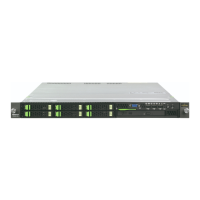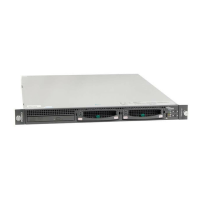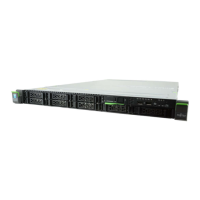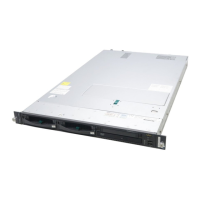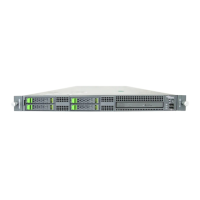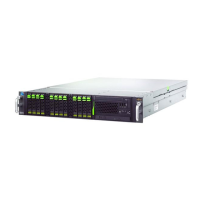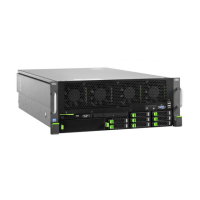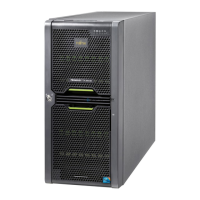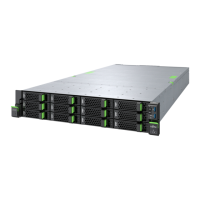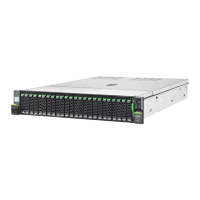Do you have a question about the Fujitsu PRIMERGY RX200 S6 and is the answer not in the manual?
Defines the manual's scope, target audience, and prerequisite knowledge for server setup and operation.
Lists other related documents and resources for more detailed information about the PRIMERGY RX200 S6.
Details the key features of the PRIMERGY RX200 S6 server, including Customer Self Service (CSS).
Explains the notational conventions used throughout the manual, such as italics, quotation marks, and warning symbols.
Provides technical specifications for the server, including electrical data, dimensions, weight, and environmental conditions.
Provides essential safety instructions for working with the server, emphasizing precautions and potential hazards.
Details ENERGY STAR compliance and notes on energy consumption affecting guaranteed properties.
States the system's compliance with EC directives for electromagnetic compatibility and low voltage.
Provides safety precautions for transporting the server, emphasizing proper packaging and handling by multiple people.
Outlines safety notes for installing the server in a rack, requiring at least two people and proper rack fitment.
Discusses environmentally friendly product design, energy saving, packaging, and handling of consumables.
Guides users on how to unpack the server, check contents, and handle it safely after delivery.
Details the process for installing and removing the server in various types of racks, including safety precautions.
Explains how to connect external devices to the server using various connectors on the front and rear panels.
Details the procedure for connecting the server to the power supply, including options for redundant power.
Provides important notes and safety precautions for connecting and disconnecting various cables to and from the server.
Details the various controls and indicators on the front and rear of the server for status monitoring.
Explains the procedures for switching the server on and off, including power button functions and other options.
Provides information on configuring the server, including SATA and RAID controllers, and OS installation.
Outlines the correct procedures and precautions for cleaning the server's external components and peripherals.
Describes how to use BIOS Setup security functions to protect data from unauthorized access and enhance system security.
Guides troubleshooting steps when the server's power-on indicator does not light up after switching it on.
Provides guidance on diagnosing and resolving issues where the server unexpectedly switches itself off.
Offers solutions for when the monitor screen remains blank or shows no display after server startup.
Addresses troubleshooting steps for flickering stripes or visual distortions on the monitor screen.
Provides solutions for situations where there is no screen display or the display exhibits drifting.
Guides on how to set and correct the system date and time, and potential causes for inaccuracies.
Offers troubleshooting steps for when the server fails to boot up, especially after installing a new hard disk drive.
Explains the causes and solutions for error messages reporting hard disk drives as "dead" during system startup.
Provides steps to resolve issues where a newly added drive is reported as defective by the system.
Directs users to documentation for interpreting and resolving general error messages displayed on the screen.
Describes handling hot-plug components, including adding or replacing power supply units and HDD modules.
Guides on identifying and replacing defective non-hot-plug components like memory modules and expansion cards.
Details the system board type and chipset specifications for the PRIMERGY RX200 S6 server.
Specifies the quantity and type of processors supported by the server.
Provides details on memory slots, types, capacity, protection, and mirroring support.
Lists the available interface connectors such as USB, Graphics, Serial, and LAN ports.
Details the specifications of onboard controllers like RAID, SATA, and Remote Management Controller.
Lists the types and number of PCI-Express slots available for server expansion.
Specifies the hard disk bay configuration and accessible drive bays for the server.
Describes the operating buttons and status LEDs found on the server's control panel.
Provides information on the server's weight, including weight notes and rack mounting kit details.
Specifies the rack dimensions (W x D x H) and mounting depth for the server.
Details environmental specifications like noise emission, sound pressure, temperature, and humidity limits.
Lists the electrical specifications for the server's hot-plug power supply units.
Defines the manual's scope, target audience, and prerequisite knowledge for server setup and operation.
Lists other related documents and resources for more detailed information about the PRIMERGY RX200 S6.
Details the key features of the PRIMERGY RX200 S6 server, including Customer Self Service (CSS).
Explains the notational conventions used throughout the manual, such as italics, quotation marks, and warning symbols.
Provides technical specifications for the server, including electrical data, dimensions, weight, and environmental conditions.
Provides essential safety instructions for working with the server, emphasizing precautions and potential hazards.
Details ENERGY STAR compliance and notes on energy consumption affecting guaranteed properties.
States the system's compliance with EC directives for electromagnetic compatibility and low voltage.
Provides safety precautions for transporting the server, emphasizing proper packaging and handling by multiple people.
Outlines safety notes for installing the server in a rack, requiring at least two people and proper rack fitment.
Discusses environmentally friendly product design, energy saving, packaging, and handling of consumables.
Guides users on how to unpack the server, check contents, and handle it safely after delivery.
Details the process for installing and removing the server in various types of racks, including safety precautions.
Explains how to connect external devices to the server using various connectors on the front and rear panels.
Details the procedure for connecting the server to the power supply, including options for redundant power.
Provides important notes and safety precautions for connecting and disconnecting various cables to and from the server.
Details the various controls and indicators on the front and rear of the server for status monitoring.
Explains the procedures for switching the server on and off, including power button functions and other options.
Provides information on configuring the server, including SATA and RAID controllers, and OS installation.
Outlines the correct procedures and precautions for cleaning the server's external components and peripherals.
Describes how to use BIOS Setup security functions to protect data from unauthorized access and enhance system security.
Guides troubleshooting steps when the server's power-on indicator does not light up after switching it on.
Provides guidance on diagnosing and resolving issues where the server unexpectedly switches itself off.
Offers solutions for when the monitor screen remains blank or shows no display after server startup.
Addresses troubleshooting steps for flickering stripes or visual distortions on the monitor screen.
Provides solutions for situations where there is no screen display or the display exhibits drifting.
Guides on how to set and correct the system date and time, and potential causes for inaccuracies.
Offers troubleshooting steps for when the server fails to boot up, especially after installing a new hard disk drive.
Explains the causes and solutions for error messages reporting hard disk drives as "dead" during system startup.
Provides steps to resolve issues where a newly added drive is reported as defective by the system.
Directs users to documentation for interpreting and resolving general error messages displayed on the screen.
Describes handling hot-plug components, including adding or replacing power supply units and HDD modules.
Guides on identifying and replacing defective non-hot-plug components like memory modules and expansion cards.
Details the system board type and chipset specifications for the PRIMERGY RX200 S6 server.
Specifies the quantity and type of processors supported by the server.
Provides details on memory slots, types, capacity, protection, and mirroring support.
Lists the available interface connectors such as USB, Graphics, Serial, and LAN ports.
Details the specifications of onboard controllers like RAID, SATA, and Remote Management Controller.
Lists the types and number of PCI-Express slots available for server expansion.
Specifies the hard disk bay configuration and accessible drive bays for the server.
Describes the operating buttons and status LEDs found on the server's control panel.
Provides information on the server's weight, including weight notes and rack mounting kit details.
Specifies the rack dimensions (W x D x H) and mounting depth for the server.
Details environmental specifications like noise emission, sound pressure, temperature, and humidity limits.
Lists the electrical specifications for the server's hot-plug power supply units.
| Tcase | 77.6 °C |
|---|---|
| Bus type | QPI |
| Stepping | B1 |
| FSB Parity | No |
| Processor code | SLBV4 |
| Processor cache | 12 MB |
| Processor cores | 4 |
| Processor model | E5620 |
| System bus rate | 5.86 GT/s |
| Processor series | Intel Xeon 5600 Series |
| Processor socket | Socket B (LGA 1366) |
| Processor threads | 8 |
| Processor codename | Westmere EP |
| Motherboard chipset | Intel® 5500 |
| Number of QPI links | 2 |
| Processor frequency | 2.4 GHz |
| Processor cache type | Smart Cache |
| Processor lithography | 32 nm |
| Processor manufacturer | Intel |
| Processor package size | 42.5 X 45 mm |
| Processor front side bus | - MHz |
| Processor boost frequency | 2.66 GHz |
| Processor operating modes | 64-bit |
| ECC supported by processor | Yes |
| Supported instruction sets | SSE4.2 |
| Thermal Design Power (TDP) | 80 W |
| Number of processors installed | 1 |
| CPU multiplier (bus/core ratio) | 18 |
| Physical Address Extension (PAE) | 40 bit |
| Memory types supported by processor | DDR3 800/1066 |
| Memory channels supported by processor | Triple |
| Memory clock speeds supported by processor | 800, 1066 MHz |
| Memory bandwidth supported by processor (max) | 25.6 GB/s |
| Maximum internal memory supported by processor | 288 GB |
| HDD size | 2.5 \ |
| RAID levels | 1, 5, 6 |
| HDD capacity | 146 GB |
| HDD interface | Serial Attached SCSI (SAS) |
| Optical drive type | - |
| Total storage capacity | 292 GB |
| Memory slots | 12 |
| Internal memory | 4 GB |
| Memory clock speed | 1066 MHz |
| Internal memory type | DDR3-SDRAM |
| Maximum internal memory | 192 GB |
| Maximum graphics card memory | 32 MB |
| LAN controller | Intel® 82575EB |
| USB 2.0 ports quantity | 7 |
| Ethernet LAN (RJ-45) ports | 3 |
| Drive bays | 8 x 2.5 \ |
| Size (imperial) | 19 \ |
| Dimensions (WxDxH) | 482.6 x 765 x 43 mm |
| Motherboard manufacturer | D 3031 |
| Recommended humidity operating range | 10 - 85 % |
| Recommended operating temperature range (T-T) | 10 - 35 °C |
| Power supply type | 47 - 63 Hz |
| Power requirements | 100 - 127 V / 200 - 240 V |
| Power consumption (typical) | 770 W |
| Power supply input frequency | 50 Hz |
| Compatible operating systems | Microsoft Windows Server 2008 Microsoft Windows Server 2008 R2 (Hyper-V) Under Hyper-V are (et al): - Windows Server 2008 R2 - Windows Server 2008 - Windows Server 2003 - Windows Server 2000 Microsoft Windows Server 2003 R2 Novell SUSE Linux Enterprise Server Red Hat Enterprise Linux Citrix XenServer VMware Infrastructure VMware vSphere 4.0 |
| Management platform | iRMC S2 |
| Chassis type | Rack (1U) |
| Certification | ISO 7779; ISO 9296 |
| Processor ARK ID | 47925 |
| Intel® Turbo Boost Technology | 1.0 |
| Weight | 17000 g |
|---|
